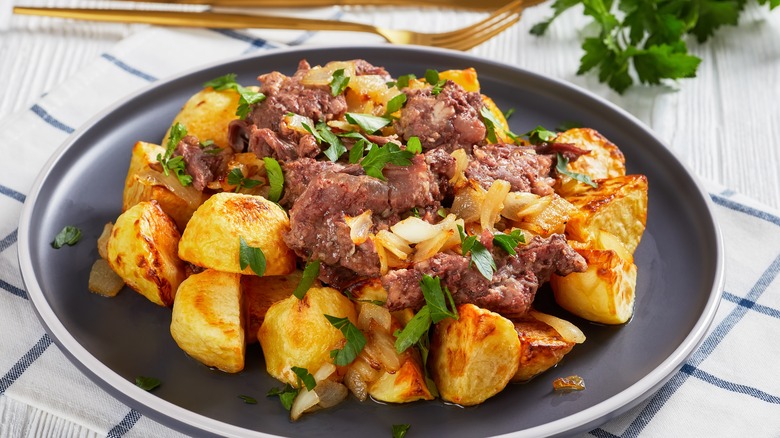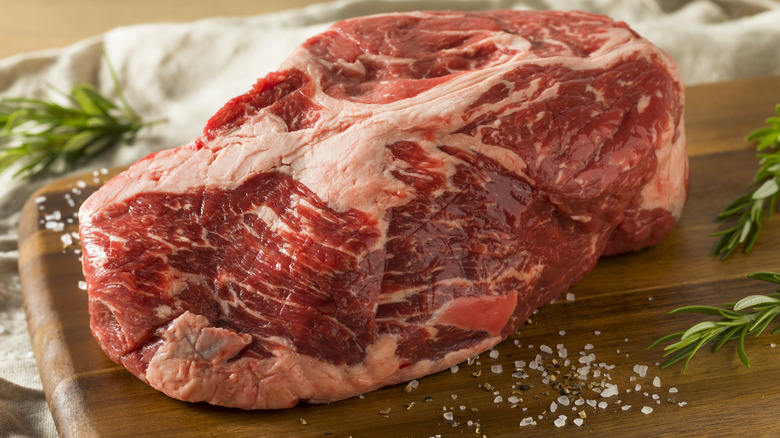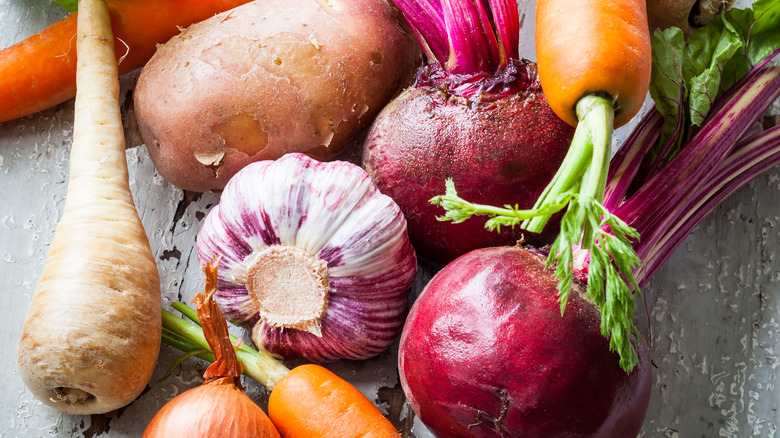The Classic Ingredients You'll Find In Yankee Pot Roast
When is a pot roast just a pot roast, and when is it something more, an elevated meal that combines all the unctuous, richness of a slowly braised piece of marbled beef with the ease of a one pot meal? Simply cooking a piece of beef low and slow with lots of liquid may yield a pot roast, but if you want to level up your game, you have to go proverbially north of the Mason-Dixon line and start making Yankee pot roast. Whereas a regular pot roast is almost free-form in its customizability, Yankee pot roast has a fairly-traditional list of ingredients that get cooked alongside the beef, lending flavors around the pot as they meld together.
Clearly, a Yankee pot roast starts off with a sizable piece of beef. Previously, we've covered the best cuts to use, and the most iconic is chuck roast, so from here we'll assume that's the cut being used. It's ribboned with plenty of fat and connective tissue that render during the long cooking process and add copious flavor, richness, and body to the final dish.
In addition to the beef, Yankee pot roast is host to a bevy of hearty root vegetables. Carrots, onions, celery, parsnips, and turnips bring their inherent sweetness to the pot, but don't feel too boxed in. While Yankee pot roast is a bit more defined than regular pot roast, you can add other vegetables of this class, such as rutabaga, radishes, or celery root.
Additional aromatics and braising liquid for Yankee pot roast
Of course, these aren't the only ingredients that make a Yankee pot roast sing. There are more minor ingredients that come together to complete the flavor profile. The chuck roast itself, in addition to being traditionally seasoned with salt and pepper, is generally floured. This may seem insiginficant, but it helps the meat develop a deeper, nuttier crust when it is seared before the braise. The flour also helps the liquid in which the meat is braised to thicken and begin its journey towards becoming a stout gravy.
Speaking of that liquid, while as inert a substance as water would technically work, Yankee pot roast uses a layered approach for bold flavor. Tomato paste is added after the searing process when initial aromatics, like mirepoix, are being sautéed in the vessel. The vegetables and tomato paste brown and help lift fond from the bottom. The beef stock is added to further deglaze and form the base of the braise. Some even add a bit of red wine, which nods to another famous beef dish, boeuf bourguignon.
Finally, additional aromatics can be added at the discretion of the chef. Garlic, minced, sliced, or even left whole, can join the mirepoix as can minced or whole herbs, like sprigs of rosemary or thyme. Note that if the herbs are left whole they should be removed before serving.
Don't overcook the vegetables when making Yankee pot roast
Regarding cooking the Yankee pot roast with its myriad ingredients, there are some important things to keep in mind. This dish is famously one that takes its time to arrive at perfection. The beef mustn't be rushed and is the central focus here. That said, many of the aforementioned vegetables, while hearty and in need of no small amount of cooking themselves, can be pushed past their prime if made to endure the entire length of the cooking process.
It's best to think of certain elements in the Yankee pot roast as flavoring agents and others as components of the final dish. Diced mirepoix, garlic, and herbs belong to the latter camp; their flavors will be coaxed out over the long haul. Larger chunks of root vegetables that you want to serve with the Yankee pot roast should be added after the chuck roast has been given a head start. That way, when the tender, fall-apart meat is plated over say creamy mashed potatoes or buttered noodles, the vegetables will be fork tender but retain their structural integrity for a toothsome bite.


